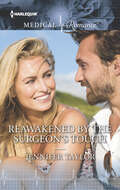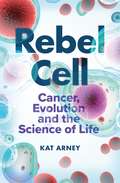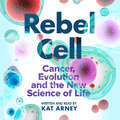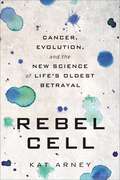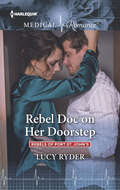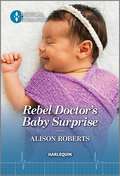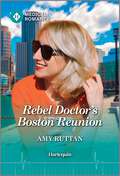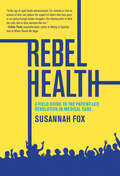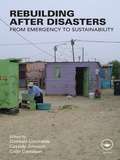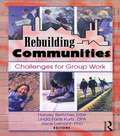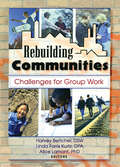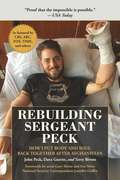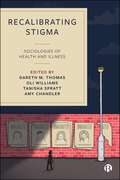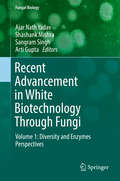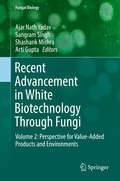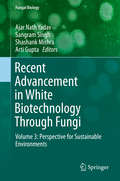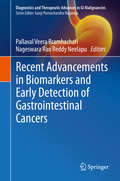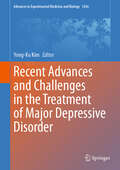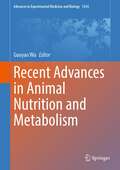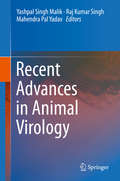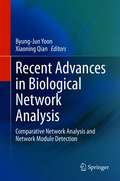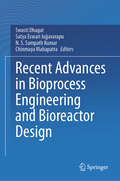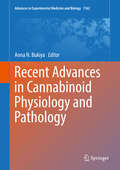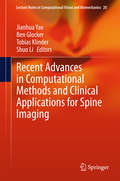- Table View
- List View
Reawakened by the Surgeon's Touch: Waking Up To Dr. Gorgeous One Kiss In Tokyo... Reawakened By The Surgeon's Touch
by Jennifer TaylorIn this sweet contemporary romance, one doctor has just the right prescription to heal his colleague’s troubled soul.When surgeon Jude Slater volunteers for a post in Mwuranda, romance is the last thing on his mind. But something about his coworker Claire Morgan unleashes emotions he’s always strove to hide.Claire can’t fall for any man until she deals with the event that haunts her and caused her escape to Africa. Yet Jude reawakens her wounded soul in ways she never thought possible. Is he the man to heal her? And in opening his heart to Claire, can Jude also heal himself?
Rebel Cell: Cancer, Evolution and the Science of Life
by Dr Kat Arney'A lively study of the Big C, which makes the case that cancer is the price we pay for our marvellously complicated bodies.' The Times, best books of 2020'This book is packed with big ideas about life. Every chapter has something in it which made me think wow. Having worked in a major cancer charity for many years, Arney writes with genuine in-depth understanding and is a perfect guide.' Daniel M. Davis, author of The Beautiful Cure'Rebel Cell is a bright, engaging read, fizzing with energy and metaphor. Kat Arney is a science writer for all of us - a powerful and talented story teller.' Stephen McGann'Kat's book is Dynamite. A crystal clear reappraisal of the story behind that word we fear to mention.' Dallas Campbell, author of Ad Astra: An Illustrated Guide to Leaving the PlanetCancer has always been with us. It killed our hominid ancestors, the mammals they evolved from and the dinosaurs that trampled the ground before that. Tumours grow in pets, livestock and wild animals. Even tiny jelly-like Hydra - creatures that are little more than a tube full of water - can get cancer. Paradoxically, many of us think of cancer as a contemporary killer, a disease of our own making caused by our modern lifestyles. But that's not true. Although it might be rare in many species, cancer is the enemy lurking within almost every living creature. Why? Because cancer is a bug in the system of life. We get cancer because we can't not get it.Cancer starts when cells revolt, throwing off their molecular shackles, and growing and dividing out of control in a shambolic mockery of normal life. This is why we can't avoid cancer: because the very genes that drive it are essential for life itself. The revolution has raged, on and off, for millions of years. But it was only in the twentieth century that doctors and scientists made any significant progress in understanding and treating cancer, and it's only in the past few decades that we've finally begun to kick the mob's malignant arse. Now the game is changing. Scientists have infiltrated cancer's cellular rebellion and are finally learning its secrets.Geneticist and science writer Kat Arney takes the reader back to the dawn of life on planet earth right up to the present day to get to the heart of what cancer really is and how by better understanding it we might one day overcome it.
Rebel Cell: Cancer, Evolution and the Science of Life
by Dr Kat Arney'A lively study of the Big C, which makes the case that cancer is the price we pay for our marvellously complicated bodies.' The Times, best books of 2020'This book is packed with big ideas about life. Every chapter has something in it which made me think wow. Having worked in a major cancer charity for many years, Arney writes with genuine in-depth understanding and is a perfect guide.' Daniel M. Davis, author of The Beautiful Cure'Rebel Cell is a bright, engaging read, fizzing with energy and metaphor. Kat Arney is a science writer for all of us - a powerful and talented story teller.' Stephen McGann'Kat's book is Dynamite. A crystal clear reappraisal of the story behind that word we fear to mention.' Dallas Campbell, author of Ad Astra: An Illustrated Guide to Leaving the PlanetCancer has always been with us. It killed our hominid ancestors, the mammals they evolved from and the dinosaurs that trampled the ground before that. Tumours grow in pets, livestock and wild animals. Even tiny jelly-like Hydra - creatures that are little more than a tube full of water - can get cancer. Paradoxically, many of us think of cancer as a contemporary killer, a disease of our own making caused by our modern lifestyles. But that's not true. Although it might be rare in many species, cancer is the enemy lurking within almost every living creature. Why? Because cancer is a bug in the system of life. We get cancer because we can't not get it.Cancer starts when cells revolt, throwing off their molecular shackles, and growing and dividing out of control in a shambolic mockery of normal life. This is why we can't avoid cancer: because the very genes that drive it are essential for life itself. The revolution has raged, on and off, for millions of years. But it was only in the twentieth century that doctors and scientists made any significant progress in understanding and treating cancer, and it's only in the past few decades that we've finally begun to kick the mob's malignant arse. Now the game is changing. Scientists have infiltrated cancer's cellular rebellion and are finally learning its secrets.Geneticist and science writer Kat Arney takes the reader back to the dawn of life on planet earth right up to the present day to get to the heart of what cancer really is and how by better understanding it we might one day overcome it.
Rebel Cell: Cancer, Evolution, and the New Science of Life's Oldest Betrayal
by Kat ArneyWhy do we get cancer? Is it our modern diets and unhealthy habits? Chemicals in the environment? An unwelcome genetic inheritance? Or is it just bad luck? The answer is all of these and none of them. We get cancer because we can't avoid it—it's a bug in the system of life itself. Cancer exists in nearly every animal and has afflicted humans as long as our species has walked the earth. In Rebel Cell: Cancer, Evolution, and the New Science of Life's Oldest Betrayal, Kat Arney reveals the secrets of our most formidable medical enemy, most notably the fact that it isn't so much a foreign invader as a double agent: cancer is hardwired into the fundamental processes of life. New evidence shows that this disease is the result of the same evolutionary changes that allowed us to thrive. Evolution helped us outsmart our environment, and it helps cancer outsmart its environment as well—alas, that environment is us. Explaining why "everything we know about cancer is wrong," Arney, a geneticist and award-winning science writer, guides readers with her trademark wit and clarity through the latest research into the cellular mavericks that rebel against the rigid biological "society" of the body and make a leap towards anarchy. We need to be a lot smarter to defeat such a wily foe—smarter even than Darwin himself. In this new world, where we know that every cancer is unique and can evolve its way out of trouble, the old models of treatment have reached their limits. But we are starting to decipher cancer's secret evolutionary playbook, mapping the landscapes in which these rogue cells survive, thrive, or die, and using this knowledge to predict and confound cancer's next move. Rebel Cell is a story about life and death, hope and hubris, nature and nurture. It's about a new way of thinking about what this disease really is and the role it plays in human life. Above all, it's a story about where cancer came from, where it's going, and how we can stop it.
Rebel Doc on Her Doorstep: Rebels Of Port St. John's (Rebels of Port St. John's #Vol. 906)
by Lucy RyderFrom one night…to forever!Dr. Paige Carlyle knows all about bad alpha boys. So when one breaks into her home, she’s ready to knock him out. But surely he’s not supposed to look that hot!Surgeon Tyler Reese wasn’t expecting a warm welcome home, but the cute, fiery pixie in residence is a complete surprise! Unable to avoid each other, soon their uneasy attraction leads to one unforgettable night. Tyler wasn’t staying forever, but now he might not be able to walk away…
Rebel Doctor's Baby Surprise (Daredevil Doctors #2)
by Alison RobertsA doctor gets the shock of his life when a woman turns up with a baby in tow…claiming the child is his daughter! Read on in the second installment in Alison Roberts&’s Daredevil Doctors duet. A NEWBORN ON HIS DOORSTEP Dr. James&’s world is turned upside down with the arrival of a stranger, nurse Sarah. Because Sarah is not alone. She&’s holding a tiny bundle—his surprise daughter! As if the situation isn&’t complicated enough, he feels an immediate connection to baby Ivy&’s beautiful guardian. And as this rebel doc opens his home—temporarily!—to this makeshift family, walking away with his heart intact soon becomes impossible…From Harlequin Medical: Life and love in the world of modern medicine.Daredevil Doctors Book 1: Forbidden Nights with the ParamedicBook 2: Rebel Doctor's Baby Surprise
Rebel Doctor's Boston Reunion
by Amy RuttanWorking with an ex isn&’t exactly ideal. But when these two doctors are reunited, they&’re shocked to discover the desire between them hasn&’t gone anywhere… Read on in Amy Ruttan&’s latest medical romance! NEW CITY, OLD FLAME…SECOND CHANCE? Ambitious oncologist Madison will do anything to further the fight against the disease that claimed her mother. Including accepting a position with Dr. Antonio Rodriguez! It&’s been ten years since she walked away from their doomed romance. Risk-averse Tony never approved of Madison&’s maverick streak, so she&’s braced for friction, not a red-hot reunion! Yet eventually it&’s their differences that makes them Boston&’s most elite team. And if work&’s great, a relationship could be, too. If the rebel doc can convince the cautious surgeon to take the biggest risk of all…From Harlequin Medical: Life and love in the world of modern medicine.
Rebel Health: A Field Guide to the Patient-Led Revolution in Medical Care
by Susannah FoxAn action-oriented and radically hopeful field guide to the underground, patient-led revolution for better health and health care.Anyone who has fallen off the conveyer belt of mainstream health care and into the shadowy corners of illness knows what a dark place it is to land. Where is the infrastructure, the information, the guidance? What should you do next? In Rebel Health, Susannah Fox draws on twenty years of tracking the expert networks of patients, survivors, and caregivers who have come of age between the cracks of the health care system to offer a way forward. Covering everything from diabetes to ALS to Moebius Syndrome to chronic disease management, Fox taps into the wisdom of these individuals, learns their ways, and fuels the rebel alliance that is building up our collective capacity for better health.Rebel Health shows how the next wave of health innovation will come from the front lines of this patient-led revolution. Fox identifies and describes four archetypes of this revolution: seekers, networkers, solvers, and champions. Each chapter includes tips, such as picking a proxy to help you navigate the relevant online communities, or learning how to pitch new ideas to investors and partners or new treatments to the FDA. On a personal level, anyone who wants to navigate the health care maze faster will want to become a health rebel or recruit some to their team. On a systemic level, it is a competitive advantage for businesses, governments, and organizations to understand and leverage the power of connection among patients, survivors, and caregivers.Proactive, optimistic, and innovative, Rebel Health is a guiding light for anyone who wishes to join the health rebel alliance and become the hero of their own story.
Rebuilding After Disasters: From Emergency to Sustainability
by Colin Davidson Cassidy Johnson Gonzalo LizarraldeDisasters are not natural. Natural events such as earthquakes, floods, hurricanes, etc. become disasters because of the fragile relations that exist between the natural, human and built environments. Sadly, major disasters will always occur in towns and cities in the developing world where resources are limited, people are vulnerable and needs are particularly great. The prevailing state of emergency challenges thoughtful and sustainable planning and construction. Yet it is possible, in theory and in practice, to construct them in a way that provides a sustainable environment and improved conditions for current and future generations. Rebuilding After Disasters emphasizes the role of the built environment in the re-establishment of lives and sustainable livelihoods after disasters. Expert contributors explain the principal challenges facing professionals and practitioners in the building industry. This book will be of great value to decision makers, students and researchers in the fields of architecture, social sciences, engineering, planning, geography, and disaster recovery.
Rebuilding Communities: Challenges for Group Work
by Harvey Bertcher Alice E Lamont Linda Farris KurtzRebuilding Communities: Challenges for Group Work is a collection of research and information presented at the 18th Annual Symposium of the Association for the Advancement of Social Work with Groups. Social workers, students, educators, and practitioners will examine how group work can improve multicultural relations within the community. Through your use of the valuable suggestions in this book, you will discover new ways to help the poor in your community help themselves, while giving them a sense of power and self-esteem to help them battle racism, sexism, and shrinking economic opportunities. Through Rebuilding Communities, you will also discover a formula for global group work that will help you make a difference by applying your hometown skills to the global community. This valuable book discusses the need for you to combine energy with humility, offer assistance with the ability to listen, to intervene when necessary, and to comprehend diversity for successful and beneficial group programs. This informative guide brings to light the skills and values needed for effective group work and how combining knowledge-base and practice-base will assist you in making a positive impact on your community. With this important book, you will find a rich source of current thinking about group work practice in relation to women, violence, health problems, child welfare, and other areas, as well as group work theory to help you find the best way to help the various people of your community. Rebuilding Communities will provide you with specific ways to improve your group work skills and positively affect the individuals in your community, such as: learning that your role of caring and advocacy as a group worker must be a complete and lifelong commitment and that you must be prepared to use your skills throughout your everyday life to make a difference using the World Wide Web to form groups whose members can support one another through the anger, joy, pain, and challenges of life learning how group work can help calm the stormy transitions that adolescent immigrants face by helping them relate to other children who are in similar circumstances examining how parents of pediatric urology patients find solace through groups where they can address such sensitive issues as the future of sexual functioning and fertility for their children discovering how marathon group sessions in South Africa are helping to provide basic services to the disadvantaged with programs to facilitate interracial contact and understanding among women and programs for adolescents boys in foster careRebuilding Communities offers you a deeper understanding of the total positive effect that group work can have on various sectors of your community to help you provide better services to those in need. This unique book focuses your attention on the importance of group work to community development and even provides you with a glimpse into the future of group work. With Rebuilding Communities you will discover a multifaceted approach to solving problems that communities face to help you choose the best options for your own community and give the best possible services to the people you assist.
Rebuilding Communities: Challenges for Group Work
by Harvey Bertcher Alice E Lamont Linda Farris KurtzRebuilding Communities: Challenges for Group Work is a collection of research and information presented at the 18th Annual Symposium of the Association for the Advancement of Social Work with Groups. Social workers, students, educators, and practitioners will examine how group work can improve multicultural relations within the community. Through your use of the valuable suggestions in this book, you will discover new ways to help the poor in your community help themselves, while giving them a sense of power and self-esteem to help them battle racism, sexism, and shrinking economic opportunities. Through Rebuilding Communities, you will also discover a formula for global group work that will help you make a difference by applying your hometown skills to the global community. This valuable book discusses the need for you to combine energy with humility, offer assistance with the ability to listen, to intervene when necessary, and to comprehend diversity for successful and beneficial group programs. This informative guide brings to light the skills and values needed for effective group work and how combining knowledge-base and practice-base will assist you in making a positive impact on your community. With this important book, you will find a rich source of current thinking about group work practice in relation to women, violence, health problems, child welfare, and other areas, as well as group work theory to help you find the best way to help the various people of your community. Rebuilding Communities will provide you with specific ways to improve your group work skills and positively affect the individuals in your community, such as: learning that your role of caring and advocacy as a group worker must be a complete and lifelong commitment and that you must be prepared to use your skills throughout your everyday life to make a difference using the World Wide Web to form groups whose members can support one another through the anger, joy, pain, and challenges of life learning how group work can help calm the stormy transitions that adolescent immigrants face by helping them relate to other children who are in similar circumstances examining how parents of pediatric urology patients find solace through groups where they can address such sensitive issues as the future of sexual functioning and fertility for their children discovering how marathon group sessions in South Africa are helping to provide basic services to the disadvantaged with programs to facilitate interracial contact and understanding among women and programs for adolescents boys in foster careRebuilding Communities offers you a deeper understanding of the total positive effect that group work can have on various sectors of your community to help you provide better services to those in need. This unique book focuses your attention on the importance of group work to community development and even provides you with a glimpse into the future of group work. With Rebuilding Communities you will discover a multifaceted approach to solving problems that communities face to help you choose the best options for your own community and give the best possible services to the people you assist.
Rebuilding Sergeant Peck: How I Put Body and Soul Back Together After Afghanistan
by John Peck Dava Guerin Terry Bivens"Marine Sgt. John Peck is a survivor, but he is also a thriver. His story still makes me smile. I am so grateful that he entered our lives.”—Jennifer Griffin, FOX News Marine Sgt. John Peck survived an IED during the War on Terror that left him with a traumatic brain injury, amnesia, and cost him his marriage. He survived another three years later, one that left him with three and a half limbs missing. He’s one of only two living people to survive the flesh-eating fungus he contracted in recovery at Walter Reed, one that left him as a quadruple amputee. And that’s only the beginning of his story. What followed was a recovery nothing short of miraculous. With resilience and the help of advocates like actor and philanthropist Gary Sinise, FOX’s Jennifer Griffin, and Bill O’Reilly, John would use a specialized “Action Trackchair” wheelchair and a newly-built SmartHome to get a third lease on life. In 2016, Peck underwent a groundbreaking bilateral arm transplant, receiving two new arms. To date, the surgery has been successful. Today, Peck is a motivational speaker, a philanthropist for veteran and wounded warrior causes, and is pursuing his lifelong dream of becoming a chef with the help of Chef Robert Irvine. From the lessons learned in a difficult childhood and as a homeless teenager, to dealing with depression in recovery, to learning how to chop with another man’s arms, Rebuilding Sergeant Peck is Peck’s account of an honest, visceral, and inspirational story that is truly unique.
Recalibrating Stigma: Sociologies of Health and Illness
by Gareth M. Thomas, Oli Williams, Tanisha Spratt, and Amy ChandlerAvailable open access digitally under CC-BY-NC-ND licence. Stigma has long been a central concern for social scientists studying health and illness. Yet, in existing work, stigma often escapes definition and clarification, is treated as universal and constant, and becomes a vague catch-all term for a range of conditions and situations. This book initiates a process of recalibrating the conceptualisation of stigma. The book features original analyses from early- and mid-career scholars focusing on diverse issues, including mental health, racism, sex, HIV, reproduction, obesity, eating disorders, self-harm, exercise, drug use, COVID-19, and disability. This ambitious book offers new perspectives to stimulate and intensify conversations around stigma, and highlights the valuable contributions of sociological approaches to understanding health and illness.
Recent Advancement in White Biotechnology Through Fungi: Volume 1: Diversity and Enzymes Perspectives (Fungal Biology)
by Ajar Nath Yadav Shashank Mishra Sangram Singh Arti GuptaWhite biotechnology, or industrial biotechnology as it is also known, refers to the use of living cells and/or their enzymes to create industrial products that are more easily degradable, require less energy, create less waste during production and sometimes perform better than products created using traditional chemical processes.Over the last decade considerable progress has been made in white biotechnology research, and further major scientific and technological breakthroughs are expected in the future. Fungi are ubiquitous in nature and have been sorted out from different habitats, including extreme environments (high temperature, low temperature, salinity and pH), and may be associated with plants (epiphytic, endophytic and rhizospheric).The fungal strains are beneficial as well as harmful for human beings. The beneficial fungal strains may play important roles in the agricultural, industrial, and medical sectors. The fungal strains and their products (enzymes, bioactive compounds, and secondary metabolites) are very useful for industry (e.g., the discovery of penicillin from Penicillium chrysogenum). This discovery was a milestone in the development of white biotechnology as the industrial production of penicillin and antibiotics using fungi moved industrial biotechnology into the modern era, transforming it into a global industrial technology. Since then, white biotechnology has steadily developed and now plays a key role in several industrial sectors, providing both high value nutraceutical and pharmaceutical products. The fungal strains and bioactive compounds also play an important role in environmental cleaning. This volume covers the latest developments and research in white biotechnology with a focus on diversity and enzymes.
Recent Advancement in White Biotechnology Through Fungi: Volume 2: Perspective for Value-Added Products and Environments (Fungal Biology)
by Ajar Nath Yadav Shashank Mishra Sangram Singh Arti GuptaWhite biotechnology is industrial biotechnology dealing with various biotech products through applications of microbes. The main application of white biotechnology is commercial production of various useful organic substances, such as acetic acid, citric acid, acetone, glycerine, etc., and antibiotics like penicillin, streptomycin, mitomycin, etc., and value added product through the use of microorganisms especially fungi and bacteria. The value-added products included bioactive compounds, secondary metabolites, pigments and industrially important enzymes for potential applications in agriculture, pharmaceuticals, medicine and allied sectors for human welfare. In the 21st century, techniques were developed to harness fungi to protect human health (through antibiotics, antimicrobial, immunosuppressive agents, value-added products etc.), which led to industrial scale production of enzymes, alkaloids, detergents, acids, biosurfactants. The first large-scale industrial applications of modern biotechnology have been made in the areas of food and animal feed production (agricultural/green biotechnology) and pharmaceuticals (medical/red biotechnology). In contrast, the production of bio-active compounds through fermentation or enzymatic conversion is known industrial or white biotechnology. The beneficial fungal strains may play important role in agriculture, industry and the medical sectors. The beneficial fungi play a significance role in plant growth promotion, and soil fertility using both, direct (solubilization of phosphorus, potassium and zinc; production of indole acetic acid, gibberellic acid, cytokinin and siderophores) and indirect (production of hydrolytic enzymes, siderophores, ammonia, hydrogen cyanides and antibiotics) mechanisms of plant growth promotion for sustainable agriculture. The fungal strains and their products (enzymes, bio-active compounds and secondary metabolites) are very useful for industry. The discovery of antibiotics is a milestone in the development of white biotechnology. Since then, white biotechnology has steadily developed and now plays a key role in several industrial sectors, providing both high valued nutraceuticals and pharmaceutical products. The fungal strains and bio-active compounds also play important role in the environmental cleaning. This volume covers the latest research developments related to value-added products in white biotechnology through fungi.
Recent Advancement in White Biotechnology Through Fungi: Volume 3: Perspective for Sustainable Environments (Fungal Biology)
by Ajar Nath Yadav Shashank Mishra Sangram Singh Arti GuptaOver the last decade considerable progress has been made in white biotechnology research and further major scientific and technological breakthroughs are expected in the future. The first large-scale industrial applications of modern biotechnology have been in the areas of food and animal feed production (agricultural/green biotechnology) and in pharmaceuticals (medical/red biotechnology). In contrast, the productions of bioactive compounds through fermentation or enzymatic conversion are known as industrial or white biotchnology. The fungi are ubiquitous in nature and have been sorted out from different habitats, including extreme environments (high temperature, low temperature, salinity and pH); and associated with plants (Epiphytic, Endophytic and Rhizospheric). The fungal strains are beneficial as well as harmful for human beings. The beneficial fungal strains may play important roles in the agricultural, industrial, and medical sectors. The fungal strains and its product (enzymes, bioactive compounds, and secondary metabolites) are very useful for industry (e.g., the discovery of penicillin from Penicillium chrysogenum). This discovery was a milestone in the development of white biotechnology as the industrial production of penicillin and antibiotics using fungi moved industrial biotechnology into the modern era, transforming it into a global industrial technology. Since then, white biotechnology has steadily developed and now plays a key role in several industrial sectors providing both high value nutraceutical and pharmaceutical products. The fungal strains and bioactive compounds also play an important role in environmental cleaning. This volume covers the latest research developments related to value-added products in white biotechnology through fungi.
Recent Advancements in Biomarkers and Early Detection of Gastrointestinal Cancers (Diagnostics and Therapeutic Advances in GI Malignancies)
by Pallaval Veera Bramhachari Nageswara Rao Reddy NeelapuThis book describes various novel biomarkers for the early diagnosis of gastrointestinal (GI) cancers. It also highlights recent advances in understanding the role of molecular markers and biomarkers, such as volatile biomarkers, serum biomarkers, predictive and prognostic molecular markers for the early detection of GI cancers. Further, it discusses novel biomarkers, including circulating microRNAs, serum microRNA and plasma microRNA in GI cancer. The book presents breakthrough technologies like ultra-sensitive nano-chips, nanosensors, nanodevices, biosensors, electrochemical biosensors, optical biosensors, DNA biosensors, synthetic biology devices, and 'omics' technologies for the early diagnosis of gastrointestinal cancer. In addition it examines the potential of genome-wide association studies, big data analytics, computation biology, systems biology, and nanotechnology for early diagnostics and therapeutics for gastrointestinal cancer, with a focus on personalized cancer treatment. The book is a valuable source for researchers and clinicians engaged in detection and diagnosis of gastrointestinal cancers.
Recent Advancements in the Diagnosis of Human Disease
by Irshad M. SulaimanViruses, bacteria, fungi and parasites are known to cause the most common human disease. It frequently spreads through direct contact (from human to human, animal to human), and through contaminated food or water. With the advancement of diagnostic techniques, it is now possible to rapidly identify microorganisms causing human disease and correlate with the corresponding clinical infection. Therefore, there is a need to develop robust and high-throughput diagnostic methods to prevent and control human disease of public health importance. This book entitled “Recent Advancements in the Diagnosis of Human Disease” will help the scientific community to better understand the transmission dynamics of some human diseases.
Recent Advances and Challenges in the Treatment of Major Depressive Disorder (Advances in Experimental Medicine and Biology #1456)
by Yong-Ku KimThis book reviews all aspects of major depressive disorder (MDD), casting light on its neurobiological underpinnings and describing the most recent advances in management. The book is divided into four sections, the first of which discusses MDD from a network science perspective, highlighting the alterations in functional and structural connectivity and presenting insights achieved through resting state functional MRI and the development of neuroimaging-based biomarkers. The second section examines important diagnostic and neurobiological issues, while the third considers the currently available specific treatments for MDD, including biofeedback, neurofeedback, cognitive behavioral therapy, acceptance and commitment therapy, neuromodulation therapy, psychodynamic therapy, and complementary and alternative medicine. A concluding section is devoted to promising emerging treatments, from novel psychopharmacological therapies through to virtual reality treatment, immunotherapy, biomarker-guided tailored therapy, and more. Written by leading experts from across the world, the book will be an excellent source of information for both researchers and practitioners.
Recent Advances in Animal Nutrition and Metabolism (Advances in Experimental Medicine and Biology #1354)
by Guoyao WuThis book covers hot topics in the nutrition and metabolism of terrestrial and aquatic animals, including the interorgan transport and utilization of water, minerals, amino acids, glucose, and fructose; the development of alternatives to in-feed antibiotics for animals (e.g., swine and poultry); and metabolic disorders (or diseases) resulting from nutrient deficiencies. It enables readers to understand the crucial roles of nutrients in the nutrition, growth, development, and health of animals. Such knowledge has important implications for humans. Readers will also learn from well-written chapters about the use of new genome-editing biotechnologies to generate animals (e.g., cows and swine) as bioreactors that can produce large amounts of pharmaceutical proteins and other molecules to improve the health and well-being of humans and other animals, as well as the growth and productivity of farm animals. Furthermore, the book provides useful information on the use of animals (e.g., cattle, swine, sheep, chickens, and fish) as models in biomedical research to prevent and treat human diseases, develop infant formulas, and improve the cardiovascular and metabolic health of offspring with prenatal growth restriction. Editor of this book is an internationally recognized expert in nutrition and metabolisms. He has about 40 years of experience with research and teaching at world-class universities in the subject matters. He has published more than 660 papers in peer-reviewed journals, 90 chapters in books, and authored two text/reference books, with a very high H-index of 127 and more than 66,000 citations in Google Scholar. This publication is a useful reference for nutrition and biomedical professionals, as well as undergraduate and graduate students in animal science, aquaculture, zoology, wildlife, veterinary medicine, biology, biochemistry, food science, nutrition, pharmacology, physiology, toxicology, and other related disciplines. In addition, all chapters provide general and specific references to nutrition and metabolism for researchers and practitioners in animal agriculture (including aquaculture), dietitians, animal and human medicines, and for government policy makers.
Recent Advances in Animal Virology
by Yashpal Singh Malik Raj Kumar Singh Mahendra Pal YadavThis book discusses the prominence and implication of the viral diseases that are a major threat to animals around the globe. A number of these diseases have also shown links with human populations, which has implications for public health. This book offers detailed and up-to-date information on viral diseases in livestock and poultry that were and/or are still a problem. Including cutting-edge developments, it also highlights several landmark contributions in the field of virology from India. Additionally, the book features tables and figures showing important clinical data and recommendations, with references for further information. It also explores the economic impact of viral diseases for farmers and the livestock industry, providing several examples. Further, it presents the latest information on viral diseases in global context, with a focus on state-of-art, molecular tools for the development of diagnostics, prophylactics and therapeutics. Lastly, the book also describes the challenges posed by the emerging and transboundary viral infections and our preparedness to counter them.
Recent Advances in Biological Network Analysis: Comparative Network Analysis and Network Module Detection
by Byung-Jun Yoon Xiaoning QianThis book reviews recent advances in the emerging field of computational network biology with special emphasis on comparative network analysis and network module detection. The chapters in this volume are contributed by leading international researchers in computational network biology and offer in-depth insight on the latest techniques in network alignment, network clustering, and network module detection. Chapters discuss the advantages of the respective techniques and present the current challenges and open problems in the field. Recent Advances in Biological Network Analysis: Comparative Network Analysis and Network Module Detection will serve as a great resource for graduate students, academics, and researchers who are currently working in areas relevant to computational network biology or wish to learn more about the field. Data scientists whose work involves the analysis of graphs, networks, and other types of data with topological structure or relations can also benefit from the book's insights.
Recent Advances in Bioprocess Engineering and Bioreactor Design
by Swasti Dhagat Satya Eswari Jujjavarapu N. S. Sampath Kumar Chinmaya MahapatraThis book provides insights into the recent developments in the field of bioprocess technology and bioreactor design. Bioprocess engineering or biochemical engineering is a subcomponent of chemical engineering, which encompasses designing and developing those processes and equipment that are required for the manufacturing of products from biological materials and sources, such as agriculture, pharmaceutical, chemicals, polymers, food, etc., or for the treatment of environmental process, for example, waste water. The main focus of this book is to highlight the advancements in the field of bioprocess technology and bioreactor design. The book is divided into various chapters briefing all aspects of bioprocess engineering and focusing on the advances in bioprocess engineering. The book summarizes introduction to bioprocess technology and microbiology, isolation and maintenance of microbial strains, and sterilization techniques for advanced-level students and researchers. Different models depicting kinetics of microbial growth, substrate consumption, and product formation are discussed. The applications of enzymes have increased tremendously and therefore understanding their metabolic pathways to increase yields is also briefly discussed. The calculations of mass and energy balances associated with entropy changes and free energy. This book also covers the approaches for handling different types of cell cultures and current advancements in the area of bioprocess strategies for different culture types, which scientists and researchers working in the different cell cultures can refer to. The downstream processing of various industrially important products is also a part of this book. Apart from that, the process economics which ensures the feasibility and quality of any biological process is also dealt with as the last section of the book.
Recent Advances in Cannabinoid Physiology and Pathology (Advances in Experimental Medicine and Biology #1162)
by Anna N. BukiyaThe cannabinoid system plays a central role in a wide variety of physiological functions that touch upon cardiovascular, gastrointestinal, immune, and nervous systems. Cannabinoids also play a central role in developmental physiology, management of pain, and shaping of human behaviour. Recent movements towards legalization of marijuana use have bolstered scientific interest in the cannabinoid field and led to research efforts that would unveil multi-faceted effects and mechanisms of cannabinoid presence in different organs and at various stages of development. This book summarizes the recent advances in the field of cannabinoid research at multiple levels of resolution. It spans from systemic effects of cannabinoids on development, physiological function, and prevalent pathophysiological conditions to mechanisms that govern cannabinoid interaction with their relevant protein targets at atomic resolution. This book will be of interest to a specialized audience in the fields of biochemistry, pharmacology and developmental biology but alsoto a wider readership with interest in general physiology and cannabinoid signalling in biological systems.
Recent Advances in Computational Methods and Clinical Applications for Spine Imaging
by Jianhua Yao Ben Glocker Tobias Klinder Shuo LiThis book contains the full papers presented at the MICCAI 2014 workshop on Computational Methods and Clinical Applications for Spine Imaging. The workshop brought together scientists and clinicians in the field of computational spine imaging. The chapters included in this book present and discuss the new advances and challenges in these fields, using several methods and techniques in order to address more efficiently different and timely applications involving signal and image acquisition, image processing and analysis, image segmentation, image registration and fusion, computer simulation, image based modeling, simulation and surgical planning, image guided robot assisted surgical and image based diagnosis. The book also includes papers and reports from the first challenge on vertebra segmentation held at the workshop.
